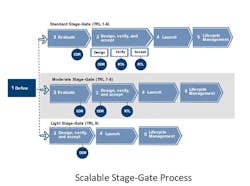How to Use a Stage-Gate Process to Manage Organizational Change
According to a recent study by KPMG, approximately 93% of all U.S. multinational organizations are undergoing some level of transformation in their business models—ranging from adjusting business lines to support the organization’s strategy to overhauling the business model to meet changes in the market or customer demands. For many organizations execution is the hardest part of any major change. Furthermore, based on recent research, APQC has found that only 30% of organizations find their change management programs effective. So what can these organizations do to manage the implementation of change?
Based on APQC’s recent best practices study Transformational Change—Making it Last, best-practice organizations keep the emphasis on change objectives through structured reviews and targeted measures of progress that help reach long-term goals. One unique approach identified in the study was how organizations can adapt product development’s traditional stage-gate process—including technical readiness ratings—to prioritize and manage transformational change efforts. This enables the organizations to pinpoint and address any changes in the business environment and develop solutions for issues or roadblocks during the implementation.
One of the best-practice organizations in the study uses a scalable, stage-gate process with standardized reviews and scorecards to track the ROI of its projects and enable problem solving (see figure below). Standardization and measurement are vital components of the stage-gate approach. So at each gate, the project team is responsible for producing and updating four deliverables (a business case, a statement of requirement, a project plan and a launch plan) to review the progress and viability of the project.
Projects are assessed using standardized scores at each review and either approved to move to the next level or sent back to the team for further refinement. The stages for product development and process improvement used by the best-practice partner follow.
Define—Develop the business case for the project (process, program, tool, or product). The project’s technology readiness level (TRL) is based on its risk, complexity and importance, which determines the rigor of its management and consequently which stage-gate process it will go through.
TRL 9 projects involve a core competency or are the equivalent of incremental innovation products or process improvements.
TRL 7-8 projects are the equivalent to adjusting a product for adjacent markets or moderate process improvements.
TRL 1-6 projects are the equivalent of disruptive innovations or new-to-the-organization processes or tools.
Evaluate—Assess the project through a conceptual design review. During this stage, the review committee assesses the project’s business case using a balanced scorecard with five categories:
1. Financial rewards—What are the financial benefits (e.g., cost-savings or revenue)?
2. Market attractiveness—What is the market growth, market size, or potential market share?
3. Competitive advantage—What unique benefits will the project create?
4. Probability of success—How likely is the project going to be successful? This is an inverse of the project’s risk or complexity.
5. Strategic alignment—Does the project meet or support the product strategy or organization’s goals?
Design, verify, and accept—Develop the new project. Once the project is designed, it goes through a detailed design review to determine if it is ready to be accepted for development. The project then is refined until it is ready to launch.
Launch—Roll out the project within the business or market. The launch stage includes the development of a formal launch plan, periodic reviews and formal post-launch assessment a year later. The post-launch review is chaired by a centralized governance team with product line and technology gatekeepers to review whether or not the project created the value it was supposed to deliver, such as profitability, cost-savings, reduced cycle time, or reliability.
Lifecycle management—Product line management or the process owner is responsible for monitoring the product during its lifecycle (the growth, maturity and decline of the revenue lifecycle). At this point, the project or product is monitored to determine when continuous improvement efforts should be made or the project/product should be retired because it no longer has an acceptable ROI.
Standardization and measurement are vital components of the stage-gate approach. For example, at each gate the project team is responsible for producing four deliverables:
A business case—outlines the project and includes its background, benefits, scope and risk assessment.
A statement of requirement—outlines the necessary resources (time, people and budget).
A project development plan—includes the project schedule and risk management plan.
A launch plan—details the project rollout to the market or organization. For complex process projects, an organizational change management representative joins the project team to manage the ADKAR (awareness-desire-knowledge-ability-reinforcement) portion of the plan.
The stage-gate process is one way of taking a structured approach to managing transformational change. Stages 1 and 2 ensure the organization is picking the best projects for its strategic goals. Stage 3 ensures execution. Finally stages 4 and 5 build in the ability to identify performance targets and use data to monitor and identify root causes to any problems. This metric-based approach uses deviation or variance and data tagging to support a continuous improvement model and react swiftly to any roadblocks or issues.
Holly Lyke-Ho-Gland is a research specialist, business excellence with APQC, a member-based nonprofit and one of the leading proponents of benchmarking and best practice business research. Working with more than 500 organizations worldwide in all industries, APQC focuses on providing organizations with the information they need to work smarter, faster, and with confidence.
About the Author
Holly Lyke-Ho-Gland
Holly Lyke-Ho-Gland is a principal research lead who conducts and publishes APQC research on process management and improvement, quality, project management, measurement, and benchmarking for APQC’s Process and Performance Management research team. Her research supports APQC members and clients across disciplines and centers on helping professionals and project managers solve business problems with strategy, process and measurement.

